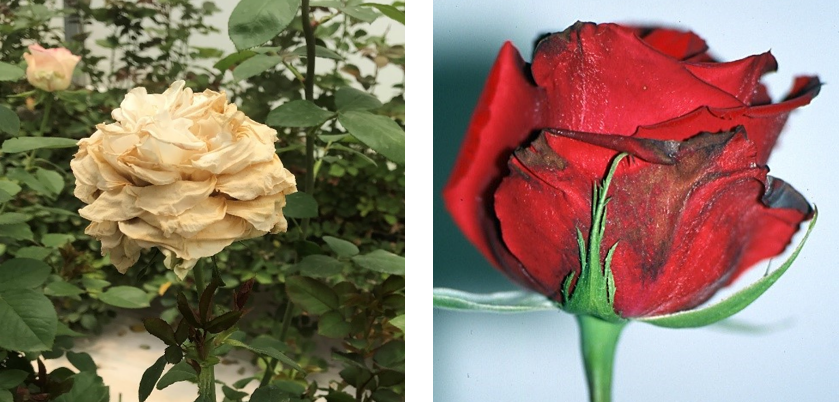Botrytis tips for early spring crops
How do I recognise Botrytis?
What are the risk conditions for Botrytis?
How do I control botrytis on the nursery?

We’ve talked about Botrytis before in these blogs but I make no apology for this quick reminder about a disease that can easily get away from you in the cool, humid conditions likely to prevail in polytunnels and greenhouses from now to the start of spring. It’s really important to stay one step ahead, paying special attention to environmental conditions and regular crop inspections.
Crops such as calibrachoa, cyclamen, dahlia, geranium, impatiens, pansy, petunia and primula are among those that are particularly vulnerable; so too are consignments in transit, as they’re likely to be carried in an enclosed humid environment, which can favour the disease, and come under more stress than when on the nursery.
Biology and symptoms
Botrytis, sometimes called grey mould, has a huge range of hosts and is caused by the fungal pathogen Botrytis cinerea. It spreads by spores in the air or splashed by water but also produces resting spores, known as sclerotia, on, for example, infected plant debris.
Spore germination depends on humidity but, once germinated, it’s leaf wetness that influences further fungal growth and spread. It particularly likes cloudy damp weather, temperatures around 16-24°C, humidity above 85% RH and when leaves remain wet for three to four hours or longer.
Initial signs of the disease may include leaf spotting and discolouration but the most distinctive symptom is the characteristic white fluffy mould, which turns grey, on leaves, stems and flowers. On bedding and pot plants, it will often be seen first on stem bases or on flowers, or anywhere the foliage is dense or in contact with growing media. Cyclamen flowers are highly vulnerable, with watery spots the first sign.
Woodier species such as heathers, hebe, ivy, lavender and rhododendron in unheated greenhouses are prone to attack as well. Symptoms include browning and dieback of shoots, and scorching of foliage, before the typical mould appears.

Beware of latent infection
In certain circumstances Botrytis can survive in plant tissue without causing obvious symptoms – a so-called latent infection. Environments that promote infection can also prompt a latent infection to turn more aggressive, resulting in symptoms. Primulas, cyclamen and poinsettias are among crops where this can be a problem.
Latent infections could be present on plant material you bring onto the nursery, or in consignments of finished crops you despatch.
When managing despatch bear in mind plant stress can also play a role in triggering symptoms from latent infections – it may be worth considering application of a biostimulant designed to mitigate the impact of stress on plants, such as Hicure.
Cultural approach
The key to managing Botrytis is keeping a lid on humidity and not allowing leaves to remain wet for too long.
Time overhead irrigation so foliage has a chance to dry during the day. Use the vents, and fans if available, to control humidity and maintain a flow of air across the plants. Good plant spacing helps too. In propagation houses, reduce misting or remove covers as soon as possible after rooting or germination.
Where heat is on hand it can be used alongside venting to control humidity. However, avoid sudden large changes in air temperature which could lead to condensation on leaves. The most effective approach is usually to apply some heat first, then to vent.
Soft growth and stressed plants are especially susceptible to infections and damaged tissue is a common entry point of Botrytis. Maintain environmental conditions that encourage active crop growth and take care to avoid over-feeding, or damage when potting and handling.
As with all diseases, good nursery hygiene plays a vital role. That includes a thorough clean, with authorised disinfectants, between crops, and replacing capillary mats if there was a significant level in the previous crop.
Also, during cropping, pick over regularly to remove any senescing leaves or flowers that could harbour spores or a latent infection.
Fungicides
An effective protectant programme is important as Botrytis is difficult to control once established. Consider starting applications soon after potting-on the most susceptible crops. Botrytis is capable of developing fungicide resistance so it’s important to alternate between fungicides with different modes of action.
Two of our broad-spectrum fungicides can form the core of a good protectant programme: Switch (cyprodinil + fludioxonil) has outstanding Botrytis control and on-label approval for ornamental plant production; Amistar (azoxystrobin) can be used under EAMUs. Amistar’s translaminar movement is useful when it’s hard to target the undersides of leaves with a sprayer.
Two of the active ingredients in these products, the cyprodinil in Switch and the azoxystrobin in Amistar, move systemically within the plant, which helps fight any latent infection that may be present.
Together, Switch and Amistar represent three different mode of action groups. You should alternate these, however, with at least one other active substance, from a different group again, known to be effective on Botrytis – and in any case Amistar should only be used preventatively to avoid the risk of resistance building up.
Switch should only be applied before flowering. While our trials have shown it to be very crop-safe across a wide range of species and varieties it can cause a phytotoxic reaction on some. As with any product, make test applications on a small batch before applying to any crop you’ve not used it on before.
Multiple applications of Switch have shown some phytotoxicity symptoms on anemone, begonia and kalanchoe, so keep to just two sprays with an extended interval of 10 days between each, for these. And we advise against any use on geranium/pelargonium.

